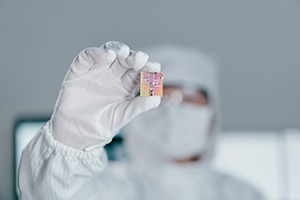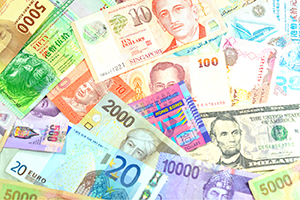How Did We Get Here? Challenging Semiconductor Times.
 Jon Y is a Taiwan-based thought leader, writer, and producer of Asianometry, a collection of science, technology, and history studies and stories seen on his YouTube channel, through his newsletter, and on social media. A main focus of Asianometry’s writings includes semiconductors around the world, from technology to financials.
Jon Y is a Taiwan-based thought leader, writer, and producer of Asianometry, a collection of science, technology, and history studies and stories seen on his YouTube channel, through his newsletter, and on social media. A main focus of Asianometry’s writings includes semiconductors around the world, from technology to financials.
The World Stopped, Technology Didn’t
Here, we’ll look at the semiconductor industry as it is today in 2022, but first, we are going to start back in 2018 and 2019, when TSMC, a major Taiwanese multinational semiconductor design and manufacturing and the semiconductor industry at large were bracing for a soft year. The macro-environment was not looking great, and as a result, growth in the semiconductor industry, excluding memory, was projected to be flat. TSMC CEO, C. C. Wei painted a rather downish view of the market. They were holding strong, buoyed by their leading-edge clients and their ability to pay for premium technologies, but the rest of the industry was not fairing as well. For the month of October 2019, the Semiconductor Industry Association reported that sales had declined 13% from 2018.
During the early days of Covid-19 in 2020, the first wave of lockdowns swept through the United States and sent economic activity to record lows. People feared the worst as automotive companies and other manufacturers halted production lines and canceled orders with suppliers. In Q1 and Q2 2020, a TSMC economist stated that the semiconductor industry would stay flat or see slight growth. In Q3, however, everything went berserk. For the longest time, mobile computing drove semiconductor industry growth. It first started with smartphones, turning into a must-have item for everyone around the globe. Those phones rapidly climbed the performance ladder as new phones began to distinguish themselves with better cameras, faster apps, and higher resolution screens. These features required faster, more powerful chips.
 TSMC and the rest of the semiconductor industry had been gearing up for 5G as a driver of the next wave of smartphone adoption. The pandemic caught them and the rest of the industry unawares because it generated demand, not from new iPhones in your pocket but rather from the data center. The pandemic moved everyone and everything to the cloud. The exploding video game industry, the direct-to-consumer streaming revolution, the work-from-home miracle, and the unprecedented surge in AI machine learning adoption. All these services must be run from data, and that cloud heft comes from hyper scalars: Amazon, Google, and Microsoft. These cloud computing companies suddenly grew 30% year over year, despite having massive revenue bases, and with themselves, as their first and biggest customer, for instance. Amazon Web Services (AWS) reported in the fourth quarter of 2021 that its revenues grew to nearly 18 billion dollars a year – that’s a whopping 40% year-over-year growth. Its revenues are now over twice that of Salesforce.com, a well-recognized cloud computing giant with a market cap of over 200 billion dollars. AWS is a juggernaut growing faster than startups, a tenth of its size. Everything related to the data center is seeing growth rates, at least in the high teens.
TSMC and the rest of the semiconductor industry had been gearing up for 5G as a driver of the next wave of smartphone adoption. The pandemic caught them and the rest of the industry unawares because it generated demand, not from new iPhones in your pocket but rather from the data center. The pandemic moved everyone and everything to the cloud. The exploding video game industry, the direct-to-consumer streaming revolution, the work-from-home miracle, and the unprecedented surge in AI machine learning adoption. All these services must be run from data, and that cloud heft comes from hyper scalars: Amazon, Google, and Microsoft. These cloud computing companies suddenly grew 30% year over year, despite having massive revenue bases, and with themselves, as their first and biggest customer, for instance. Amazon Web Services (AWS) reported in the fourth quarter of 2021 that its revenues grew to nearly 18 billion dollars a year – that’s a whopping 40% year-over-year growth. Its revenues are now over twice that of Salesforce.com, a well-recognized cloud computing giant with a market cap of over 200 billion dollars. AWS is a juggernaut growing faster than startups, a tenth of its size. Everything related to the data center is seeing growth rates, at least in the high teens.
Foundries and their suppliers have rushed to fulfill orders for these companies because the money is good. The hyper scalars can pay top dollar and spend up to 150 billion dollars yearly in capital expenditures. This is not just the server chips, CPUs, and GPUs, but also every little thing to support them, like circuit boards, resistors, and capacitors. While the rush to the data center has elbowed out other customers and their products, these chips aren’t anywhere near the leading edge (more on this later) and are nowhere near as profitable. Nonetheless, they are critical to many of today’s products because manufacturers have found that over time, the only way to add new features and capabilities to their products has been to put chips into them. Chips used to only belong in your computer, but now they are in your cars, headphones, refrigerators, earbuds, and so on.
Fast-Forward
So, the world experienced a global event in which the supply chains all stopped moving at the same time. Now they are all trying to run again at the same time, and the doors aren’t big enough to let everyone through. It was then that each country and its own flagship manufacturing industry, particularly automobiles, discovered that they could not finish and sell their products because of a missing component somewhere. There are also national security implications, as a war is going on in Europe. The world’s military suppliers are rushing to meet a sudden new demand for accelerometers, FPGAs and wideband radios. To suddenly find yourself so dependent is terrifying, and this collective realization has set off a global race for semiconductor production.
 Governments in North America, Europe, and of course, Asia have announced a desire and a budget to bring semiconductor manufacturing to their shores. But you can’t just drop a Fab (semiconductor fabrication plant) anywhere. A Fab is only the most visible part of a complete ecosystem. For example, whales swim to where the krill is; companies want to place their Fabs near their equipment suppliers, ample amounts of skill and talents, and a friendly government willing to work with them. The smart policy is to try to build the ecosystem from start to finish.
Governments in North America, Europe, and of course, Asia have announced a desire and a budget to bring semiconductor manufacturing to their shores. But you can’t just drop a Fab (semiconductor fabrication plant) anywhere. A Fab is only the most visible part of a complete ecosystem. For example, whales swim to where the krill is; companies want to place their Fabs near their equipment suppliers, ample amounts of skill and talents, and a friendly government willing to work with them. The smart policy is to try to build the ecosystem from start to finish.
Several countries have made this the target of their public policy. For instance, in 2020 and 2021, the government announced a strategy to build a “K-shape” conductor belt. Several places south of Seoul are targeted to be semiconductor cities, linking together to create a shape roughly looking like a k. The government will support this with tax and RD credits, and the plan is a public-private partnership. Private companies like SK Hynix and Samsung electronics are surveyed to spend 451 billion dollars over the next ten years. Samsung is building massive new facilities in both the United States and South Korea. Peripherally, the government will work to train 36,000 new potential workers and build water, and power infrastructures, for these forthcoming semiconductor facilities. Additionally, they signed an agreement with ASML to put a training center near Samsung manufacturing.
 Back in the 1980s, Japan was the world’s most advanced semiconductor maker, but since then, its abilities have declined. But in certain areas, the country remains formidable for semiconductor manufacturing, and they are looking to reverse these latest trends. The biggest piece of news is TSMC’s 22/28 nm Fab in Kumamoto, Japan. Worth 8.6 billion dollars over its various phases, the effort is a joint venture between TSMC and a cluster of Japanese semiconductor companies represented by Japan’s advanced semiconductor manufacturing. The Japanese government is subsidizing a substantial portion of the total cost, approximately 4 to 5 billion dollars. Kumamoto had once hosted and supported NEC during its Halcyon days in the 1980s. Sony still produces advanced image sensors in a facility nearby but no logic chips. TSMC’s Fab would be the most advanced such logic plant in the area and likely win a great deal of Japanese business while at the same time feeding into the supplier system. Intel CEO Pat Gelsinger wants to return his company to the 1990s, to be a global leader once more, by serving every feasible computing and semiconductor need. This means investing in the immense amount of money, all across the world and at all parts of the value chain. The announcements included 3 billion dollars for expanding Fab D1X in Hillsboro, Oregon, and $20 billion for constructing two new Fabs in Chandler, Arizona – Fabs 52 and 62, scheduled to come online in 2024. And another 20 billion for a Fab in Columbus Ohio. Perhaps it could come to a total of 100 billion dollars over many years.
Back in the 1980s, Japan was the world’s most advanced semiconductor maker, but since then, its abilities have declined. But in certain areas, the country remains formidable for semiconductor manufacturing, and they are looking to reverse these latest trends. The biggest piece of news is TSMC’s 22/28 nm Fab in Kumamoto, Japan. Worth 8.6 billion dollars over its various phases, the effort is a joint venture between TSMC and a cluster of Japanese semiconductor companies represented by Japan’s advanced semiconductor manufacturing. The Japanese government is subsidizing a substantial portion of the total cost, approximately 4 to 5 billion dollars. Kumamoto had once hosted and supported NEC during its Halcyon days in the 1980s. Sony still produces advanced image sensors in a facility nearby but no logic chips. TSMC’s Fab would be the most advanced such logic plant in the area and likely win a great deal of Japanese business while at the same time feeding into the supplier system. Intel CEO Pat Gelsinger wants to return his company to the 1990s, to be a global leader once more, by serving every feasible computing and semiconductor need. This means investing in the immense amount of money, all across the world and at all parts of the value chain. The announcements included 3 billion dollars for expanding Fab D1X in Hillsboro, Oregon, and $20 billion for constructing two new Fabs in Chandler, Arizona – Fabs 52 and 62, scheduled to come online in 2024. And another 20 billion for a Fab in Columbus Ohio. Perhaps it could come to a total of 100 billion dollars over many years.
Intel has given a lot of attention to Europe by tapping into the country’s National Security concerns, thus rumblings of $20 billion for constructing a facility in Magdeburg, Germany, and another 8 billion for FAB 34 in Intel’s Ireland location, scheduled to come online in 2023. More interesting builds: $11 billion for a new FAB and a $5 billion upgrade to an existing FAB in Israel. All this investment, and we haven’t even touched on the investments made in the backend facilities. Anyway, many of these Investments have been made on the back of an anticipated $50 billion in subsidies coming from the American government via the Chips Act.
The Knife’s Edge
 Now let’s move to another part of the industry, the part dealing with the production technologies themselves. Today’s modern semiconductor manufacturing industry is walking on a knife’s edge, an edge that is both technical and economic. Semiconductor manufacturing is the most sophisticated unforgiving, high-volume production technology that has ever been done successfully. For the first six years of the semiconductor industry, manufacturers improved performance by cramming more transistors onto a single dye. In the 1990s, Intel managed to move from the 800-nanometer node to the 130-nanometer node – In 11 years – incredible progress. But progress since then has drastically slowed; it took 11 years to shrink 670 nm, and it would take 14 years to go from 90 nm to 14. And today, the cost of developing the next node is in the billions. And the hardest part of skyrocketing node prices is the cost of semiconductor equipment. The first Micro Line, 100 made by PerkinElmer, was sold to Texas Instruments in 1974 at the cost of 98 thousand dollars. Today at ASML high-end extreme ultraviolet (EUV) machine costs $300 million, roughly the cost of a single Boeing 787 airplane.
Now let’s move to another part of the industry, the part dealing with the production technologies themselves. Today’s modern semiconductor manufacturing industry is walking on a knife’s edge, an edge that is both technical and economic. Semiconductor manufacturing is the most sophisticated unforgiving, high-volume production technology that has ever been done successfully. For the first six years of the semiconductor industry, manufacturers improved performance by cramming more transistors onto a single dye. In the 1990s, Intel managed to move from the 800-nanometer node to the 130-nanometer node – In 11 years – incredible progress. But progress since then has drastically slowed; it took 11 years to shrink 670 nm, and it would take 14 years to go from 90 nm to 14. And today, the cost of developing the next node is in the billions. And the hardest part of skyrocketing node prices is the cost of semiconductor equipment. The first Micro Line, 100 made by PerkinElmer, was sold to Texas Instruments in 1974 at the cost of 98 thousand dollars. Today at ASML high-end extreme ultraviolet (EUV) machine costs $300 million, roughly the cost of a single Boeing 787 airplane.
It is not just lithography of equipment; evaporators back in the 1970s cost just a few thousand dollars per unit. Today each unit costs north of $4 million. As a result, the industry has had to evolve to develop new ways to improve performance—for instance, immersion lithography, extensive multi-patterning, and the use of advanced packaging techniques with chipletts.
Affording the Future
These are all interesting technologies, but their adoption underlines a critical message, each new node generation demands more from all of its participants technically and financially, and it sets the bar for investment payback to be much higher. And not every chip designer is willing to or has the economics to pay for that. So, what does that mean?
 The Foundry has to make their money back. So their model has been to first sell to Flagship customers like Apple and AMD the high-margin server and mobile processor chips. Those customers are more than willing to pay that because they have the scale and the need for it, as mentioned about the hyper scalars. Over time, the equipment gets sufficiently depreciated, and prices fall, making the node cheap enough for a new generation of users. The other guys scale up their designs to the next node and take over capacity, and ideally, the plant ages gracefully until it’s finally decommissioned.
The Foundry has to make their money back. So their model has been to first sell to Flagship customers like Apple and AMD the high-margin server and mobile processor chips. Those customers are more than willing to pay that because they have the scale and the need for it, as mentioned about the hyper scalars. Over time, the equipment gets sufficiently depreciated, and prices fall, making the node cheap enough for a new generation of users. The other guys scale up their designs to the next node and take over capacity, and ideally, the plant ages gracefully until it’s finally decommissioned.
There are roughly 200 Fabs around the world. Less than a dozen of them are actually at the leading edge, meaning they are making chips using a sub 10 or even 20 nm process. Most of the rest were built before 2000 but work perfectly fine, producing very cheap chips with fully amortized equipment. Though, they are the silver foxes of the semiconductor world. This was how it worked for a very long time, but the pandemic in the cloud revolution messed up this entire dynamic. Why is there a ridge because customers’ trailing edge chip demand are all piled up at nodes like 28 nm. One of the most advanced nodes still using a planar gate. Any node newer than 20 nm means having to deal with field-effect transistors (FinFETs) rampant multi-patterning and extreme ultraviolet (EUV) technology. 20 nm represents the bottom of the cost curve on a 100 million gate basis.
Since 2019 Fab utilization rates have risen beyond their long-term targets of 80%, hitting levels in the mid-90s. It’s an indication that foundries are pushing the limit in terms of what they can squeeze out of what they already have. But the customers are used to paying prices set by foundries with fully depreciated Fabs. Yet, at those same prices, the Fabs aren’t willing to buy new equipment or build an entirely new Fab. Without government subsidies or a price increase, supply and demand cannot make a deal.
Thanks to the miracle of capitalism, things will eventually adjust. TSMC is first through the breach by building those Fabs enforcing through price increases to those trailing edge customers. For the rest of the industry, they must make the best economic decision for themselves. Rather than splashing out for a brand spanking new Fab, consider the more immediately profitable action of improving internal operations. Reducing downtime, saving on energy, usage, and of course, raising yields will make the most of this unique market situation and directly contribute to the bottom line.
If I were running a semiconductor foundry, this low-hanging fruit would be what I’d reach for first. It’s a no-brainer decision. Just have to get them to realize it.
Thanks for reading. JonY
Learn more about the analytical testing solutions serving to improve semiconductor manufacturing processes and product quality.

